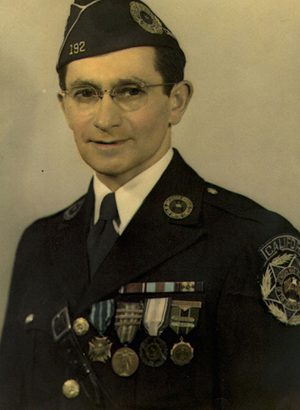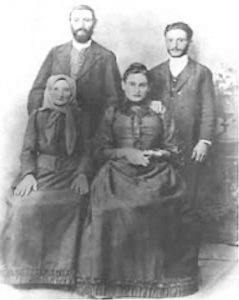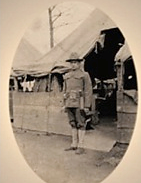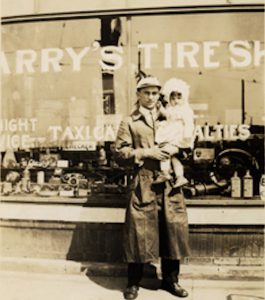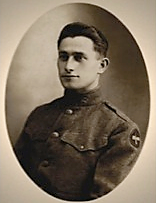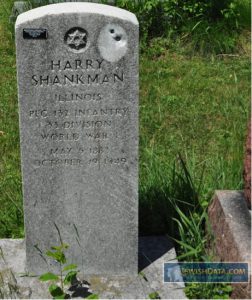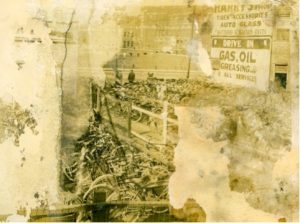By Ronald Miller
If you are starting your own genealogy journey to learn your family history, I hope my experiences will be helpful and encouraging.
I got hooked on genealogy while attempting to solve a family mystery: What was the true surname of my maternal grandfather Harry Shankman? This account illustrates the variety of materials, methods, and sources I used. It also illustrates how names, dates and other information vary by document and time. They must not be totally relied upon when searching for and vetting other documents. Not only did I resolve my mystery, but I discovered a wealth of information about other ancestors. I also learned quite a bit of U. S. and world history.
My older brother had compiled a family tree by interviewing many older relatives; but it was on paper with no copy. A relative borrowed it, and lost it. By the time it was lost, most of the older relatives had passed away, along with their memories of family names and stories of the old country. My brother never continued with genealogy after losing his years of research.
Family Stories
After retiring, I decided to pursue our family genealogy and especially the mystery of my grandfather’s name. My mother and her sister, my Aunt Millicent, told me that according to the family oral history, their father, Harry, lived with the Shankman family in New York City when he came to America from Russia as a teenager and he took their surname because they treated him so kindly. We still don’t know why he lived with them when he arrived in America.
Harry then left New York and settled in Chicago with his mother and stepfather. All that my mother and aunt knew of their father’s ‘real’ surname was the phonic Crasnitsky, that he came from Kiev, Russia, and that his father died in Russia when he was a child.
My aunt Millicent recalled visiting the Shankman family in New York when she was young but could not remember any names, addresses, or other details in the intervening 50 years. Harry’s mother remarried in Russia and had four children with her second husband, Max Skolnick, before immigrating to America.
What I also knew about my grandfather was that he was a World War I veteran who later died from the effects of being gassed during a battle. I was five years old when he died and have no memory of ever meeting him. I also knew that he owned a bicycle store across the street from Chicago’s Lane Technical High School.
1920 Census
My search for Harry’s real surname began with the 1920 U. S. Census. My goal was to find any data that could lead to other documents. When I began my genealogy research in 1994, the Internet was still in its infancy. I found genealogy resources at a local LDS Family History Library. I requested the 1920 U. S. Census, which was available on microfilm, and used the Soundex system to search through the phonetically coded surnames. Analysis of the 1920 census form entries was the start of my steep learning curve as I began my research journey.
The 1920 census listed my grandfather as Harry Shankman, age 26 (estimated date of birth 1894), immigrating in 1913, naturalized in 1917, born in Russia, and unable to speak English. And based on the census age of 26 in 1920, and immigration in 1913, Harry would have been 19 when he arrived. When I asked my mother why my grandfather could not speak English but served in the U. S. Army and was a WWI combat veteran, she told me he had a heavy Russian accent but spoke and understood English. (See the 1920 Census here.)
My later research ultimately revealed that most of the census data was incorrect.
Naturalization
Harry’s ship passenger manifest surname was not going to be Shankman. I knew that once I discovered his real surname I could probably find his name on a ship manifest. This assumed that the manifest existed, and was readable.
Some original manifests were destroyed, and some microfilmed copies are illegible.
Family mystery solved! Harry Shankman’s Naturalization Petition forms revealed his original surname as Harshel Crasnitzsky and place of birth as Rzeshtcheve, Russia. And his ‘real name’ was added after the entry of Harry Shankman on the document. It seems obvious that the person reviewing his application must have asked if Harry was known by any other name. They added his Russian name as part of his naturalization. There was a form officially changing his name from Harshel Crasnikzky to Harry Shankman.
Harry Shankman was approved as a US citizen on April 7, 1920, as indicated on his Naturalization Petition. He married my grandmother, Rosabel Golden, ten days later, on April 18, 1920, although his Naturalization Certificate has the effective date as May 14th, 1920. (See Harry’s Naturalization Certificate here.)
Ship Passenger Manifest
I was able to find the date, port, and ship passenger manifest of his arrival from information on his Naturalization Petition application. Harry arrived on the ship M/V Russia which left Libau, Russia (a port on the Baltic Sea), on July 19th and arrived in New York, Ellis Island, on August 1, 1910. Why did his 1920 census list his arrival year as 1913? Probably because whomever provided the answers to the census taker could not remember, or perhaps the census taker could not understand the Russian accented answers.
The manifest entry for Harry reads Krasnitzky, Herschel (as I interpret the written script), age 16. The transcriber of this manifest for ellisisland.org recorded his name as Gerschko, but a careful look reveals the correct interpretation is Herschel.
The manifest listed his place of birth as Rzeshtchieve, Kiev (now in Belarus); his occupation as shoemaker; and his destination as his Uncle Max Skolnic, 469 Wabash Ave, Chicago, Illinois. Eventually I was able to document that Harry’s stepfather Max had arrived in America in 1907 and lived in Chicago; Harry arrived in 1910; and Harry’s mother, Bessie Skolnick, and her four children, Harry’s half-siblings, arrived in 1911.
Harry’s manifest showed that he was detained for being a likely public charge (LPC), and was subject to deportation until he convinced officials otherwise. It must be assumed that Harry was able to verify he would be living with his stepfather and would not be dependent on government assistance.
The LPC documents were added to the manifests by Ellis Island immigration inspectors after the ship arrived and the passengers were processed. The LPC page was typewritten. Thus, the spelling of his typed name was easier reading than the written manifest page that the ship deposited with Ellis Island authorities. The typed entries included names that were corrected.
Military Service and Post War Occupations
In 1917 Harry was drafted into the United States Army and served overseas during World War I. His WWI Draft Registration shows him born Kiev, Russia, May 5th, 1894, and working as a shoe examiner at Sears & Roebuck. (See Draft Registration Card here.)
A certificate issued in 1929 certified Harry as a member of Company “L” in a veteran’s fraternal organization that held gatherings annually. My mother remembered attending picnics that were sponsored by the organization. Col. Abel Davis, the regimental commander, attended these events and wrote a history of the 132nd Infantry’s WWI involvement.
Harry Shankman first arrived in France in May 1918. A myriad of details concerning WWI is contained in a variety of military documents and unit histories that are available in libraries, online, and at the NARA military archive in College Park, MD. The following extracts provide details on his war service.
From August 8 – 13, 1918, Harry participated in the Somme Offensive Operation. During this time, the 3rd battalion of the 132nd Infantry Regiment, which included Harry’s Company “L,” fought in many famous battles.
His 3rd battalion was involved in the Meuse-Argonne Operations and took part in the attack on Bois De Fays. Harry’s battalion was exposed to intense artillery and machine gun fire and gas. The advancing lines were subject to artillery fire and gas causing the unit to suffer many casualties. Hand-to-hand fighting occurred frequently and machine gun nests were numerous and strongly placed. Every foot of the advance was contested. The fighting was so fierce that the troops could not be provided with proper rations.
During one battle, every officer in Harry’s Company “L” was killed or wounded and the company was commanded by the First Sergeant until the objective had been reached. Harry might have been gassed during this battle; he died in 1949 from the after effects of being gassed.
After the battle of Bois de Fays, the 3rd battalion attacked the enemy and drove them to the north edge of town. Later, they received word of the armistice (signed at the 11th hour, of the 11th day, of the 11th month of the year). During this last day of the war, Company “L” suffered one killed and six wounded.
Military veterans have been given Naturalization preference since 1862. Harry used an updated May 9, 1918, Act of Congress to apply for his citizenship without having to wait five years. On April 7, 1920, Harry was certified eligible to become an American citizen.
Harry’s WWI draft registration card listed his employment as a shoe examiner at Sears Roebuck & Co. The 1920 Census listed his occupation as a store shoe clerk. The Chicago City Directory of 1923 shows Harry as a shoe cutter, living at 3332 Grenshaw. Address information is often useful for census searches and validating other documents.
Harry later opened Harry’s Bicycle & Tire Shop on North Western Avenue in Chicago, across from Lane Technical High School. The 1930 Chicago City Directory entry lists Harry’s Tire Shop.
Harry registered in 1942 for the fourth of six WWII draft registrations that was called the ‘Old Man’s Draft’ because of the men’s ages. They did not register to serve in the military but in an effort to determine an inventory of wartime manpower. This registration listed him as living in Los Angeles. Harry traveled to California for health reasons as the climate was better for his lung condition. Harry keep the draft board advised of his current address.
Harry was active in veteran’s organizations after WWI. He was also a member of the Veterans of Foreign Wars, the American Legion, and the Jewish War Veterans. Over the years he served as Commander of his local chapters.
I obtained his membership applications and membership history by contacting the organizations.
Death and Burial
My grandfather Harry died in 1949 at the age of 55. My mother received a Western Union telegram. I attempted, unsuccessfully, to obtain his medical records from the Veterans Administration Hospital.
The California Death Index, available via Ancestry.com, lists his correct birth date as confirmed by the funeral home based on information provided by the family. It includes an incorrect surname for his father, but does have Harry’s social security number, so a Social Security Form-5 could be requested. I recently received the Form-5 Application for Social Security Account Number that Harry completed in 1943, with yet another spelling of his father’s surname as Krasnitskie.
Harry’s U. S. government provided gravestone has the incorrect date of birth listed: 1883 instead of 1893. And the photo on the stone was vandalized. The gravestone image is available from jewishdata.com and findagrave.com.
Family History Photos and Documents
Family photos documented the Shankman family, although many were ruined or lost over the years. I lost all my genealogy printed documents and materials when Hurricane Katrina destroyed my house while I was away and 28 plus feet of water covered our one-story home. All I had left was my laptop containing some records and photos. Family members and friends were able to provide their copies of some materials, but most were lost.
It should be obvious that I would conclude with the admonition to back-up your genealogy data. And keep in mind that technology changes. I have some old files that cannot be read due to changes in file formatting and unsupported software programs. Many computers will not open older files created by earlier versions, and some file formats cannot be converted, and some images cannot be viewed. You don’t need a scanner to copy photographs as most cameras, including smart phones, have adequate resolution for preserving documents. Having a photo of a document or an artifact is better than having none if they are destroyed by fire, flood, or other calamities. And we discovered that our bank safe deposit box was fireproof, not water proof.
A photo showing Harry’s tire store, although damaged by water, continues to provide details of his business operation.
What I Learned and the Resources I Used
The end result of my quest to discover my grandfather’s ‘real’ surname was a success. My research ultimately revealed that Hershel Krasnitzky, now known as Harry Shankman, arrived by himself at Ellis Island in 1910, age 16. He was born in Rzeshtchieve, near Kiev, Russia on May 5th, 1893, and was the son of Lazar Krasnitzky and Chani (Bessie) Kaplan.
I also discovered a treasure trove of family history along the way. I created a family history website at ronaldimiller.com/wp. Many schools today teach an introduction to genealogy and my website is used by my young relatives to learn about their ancestors’ emigration from the old country, seeking a new life and freedom in America.
While researching my grandfather’s original surname, and researching other family members, I learned a great deal about family history research. This included using Internet search engines and resources such as Google, JewishGen, Rootsweb, Yad Vashem, ancestry.com, stevemorse.org, the National Archives (NARA) website, familysearch.org, and more; visiting NARA facilities where personal visits are sometimes required; visiting the LDS archives at Salt Lake City and local LDS Family History Libraries; visiting local, state and county historical societies; using various state, city, and county vital records offices; the courts (federal, state and local); researching naturalization, divorce, ship manifests, birth, death, marriage, military, and other records. I learned to use a variety of microfiche and microfilm readers.
Important information was often added with help of the Library of Congress genealogy staff, newspaper morgues, city directories, cemeteries, library archives, relatives, friends, and contacts I made through JewishGen and other on-line sources.
Family memorabilia has added to my family history. Some documents and websites are in foreign languages and must be translated. There are a variety of online options for obtaining translations, including JewishGen’s View Mate program and Google Translate to translate documents, webpages, or even entire websites. There are also many mapping websites, such as Google Maps, Google Earth, and Mapquest.
Many genealogy software programs are available to record and preserve information. Storycorps.org is an audio/video recording program that can be used to preserve family histories. I have used a variety of genealogy software over the years and found all had pros and cons, depending on the user’s objectives.
A wealth of information is available revealing the history of the Pale of Settlement where many of my Russian Empire ancestors’ shtetls (villages) were located, and how they migrated from the Middle East centuries ago. Memorial websites preserve their memories and Yizkor books commemorate the personal memories and histories of these villages. Many Yizkor books are available online, and many have been translated into English.
In summary, there are a wealth of resources for discovering and preserving your family history. Whether you are just beginning your own genealogy journey, or you are a more experienced family history researcher, I hope my experiences will be helpful and encouraging.
September 2018
Chicago, Illinois, USA
Note: A longer version of the above account, including additional photographs and documents, was published in the Summer 2014 Issue of Morasha, Vol. XXIX, Number II, a publication of the Jewish Genealogical Society of Illinois; reprint permission granted. https://www.jgsi.org/
More about the Shankman story can be seen at Ronald Miller’s genealogy website at: http://ronaldimiller.com/wp/how-i-became-hooked-on-genealogy/
Research Notes and Hints
Ronald Miller provides a roadmap for his successful family history research. He was diligent and thorough in using online resources as well as making visits to various facilities to obtain documents not available on the Internet. He learned to keep in mind that names and dates can vary from document to document.
In his story, Ronald provides a comprehensive list of resources he used in his research, including the resources of JewishGen.
For more information about his extensive family research into various branches of his family, see Ronald’s genealogy website at:
